Solution to HA1011 Applied Quantitative Methods Assignment 2
VerifiedAdded on 2023/04/03
|13
|1105
|155
Homework Assignment
AI Summary
This assignment solution covers various quantitative methods, including frequency distribution, histogram creation, and calculations of mean, median, mode, standard deviation, and interquartile range. It interprets correlation coefficients and develops a regression equation to model the relationship between weekly attendance and chocolate bar sales. The solution also includes probability calculations for different events and applies binomial and Poisson distributions. Furthermore, it addresses normal distribution assumptions and calculates probabilities related to apartment sales and investor willingness. The document is a comprehensive guide to understanding and applying quantitative methods in a business context, made available for students on Desklib, where they can find more solved assignments and study resources.
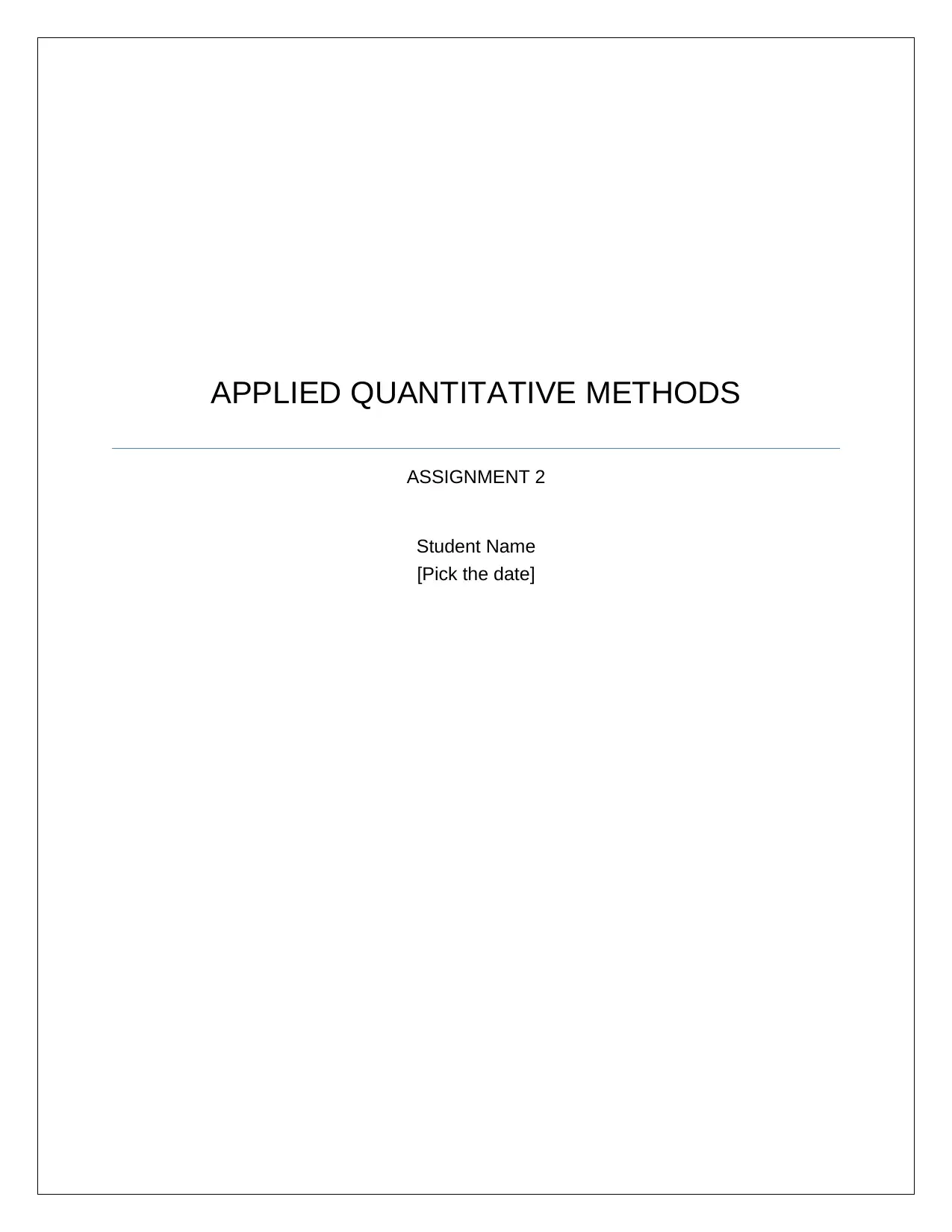
APPLIED QUANTITATIVE METHODS
ASSIGNMENT 2
Student Name
[Pick the date]
ASSIGNMENT 2
Student Name
[Pick the date]
Paraphrase This Document
Need a fresh take? Get an instant paraphrase of this document with our AI Paraphraser
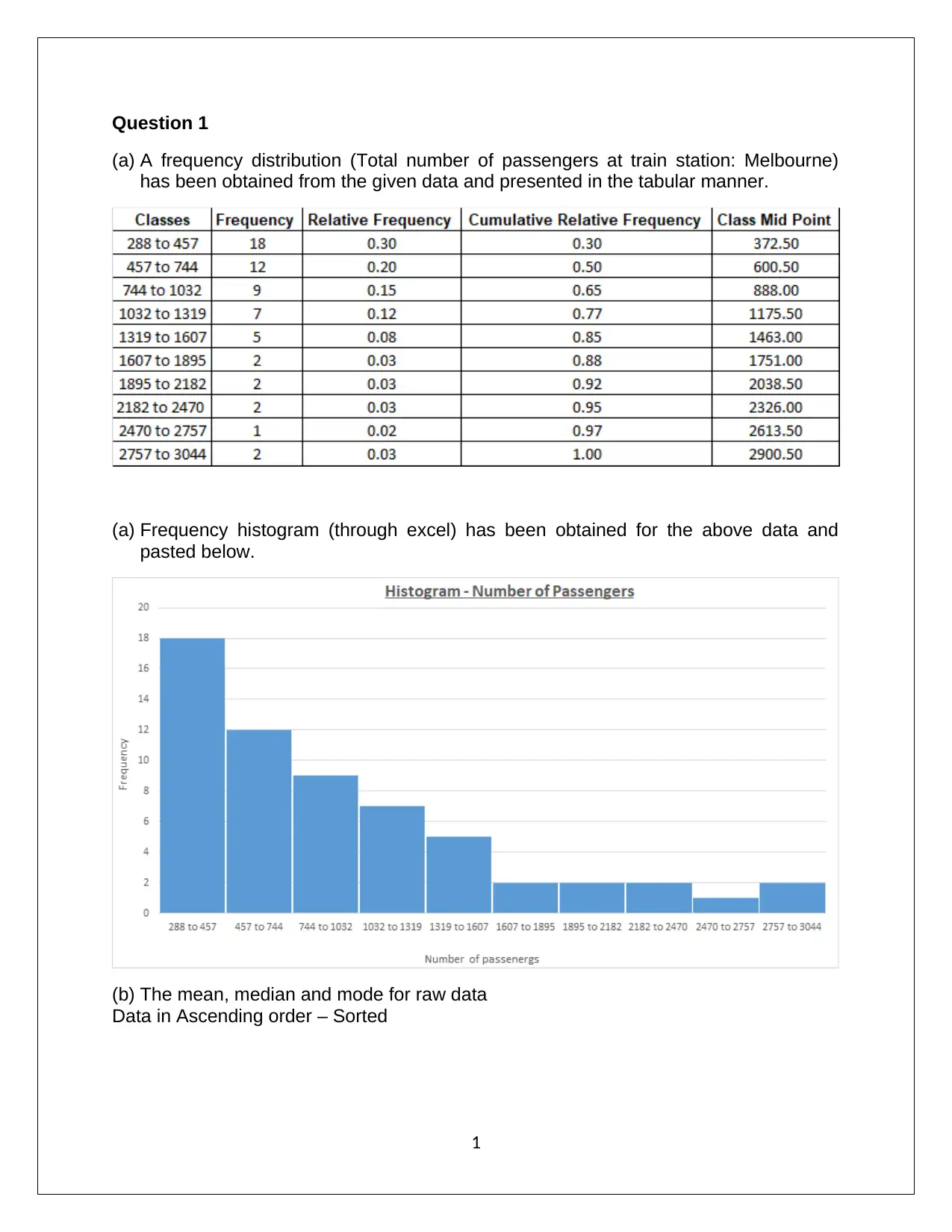
Question 1
(a) A frequency distribution (Total number of passengers at train station: Melbourne)
has been obtained from the given data and presented in the tabular manner.
(a) Frequency histogram (through excel) has been obtained for the above data and
pasted below.
(b) The mean, median and mode for raw data
Data in Ascending order – Sorted
1
(a) A frequency distribution (Total number of passengers at train station: Melbourne)
has been obtained from the given data and presented in the tabular manner.
(a) Frequency histogram (through excel) has been obtained for the above data and
pasted below.
(b) The mean, median and mode for raw data
Data in Ascending order – Sorted
1
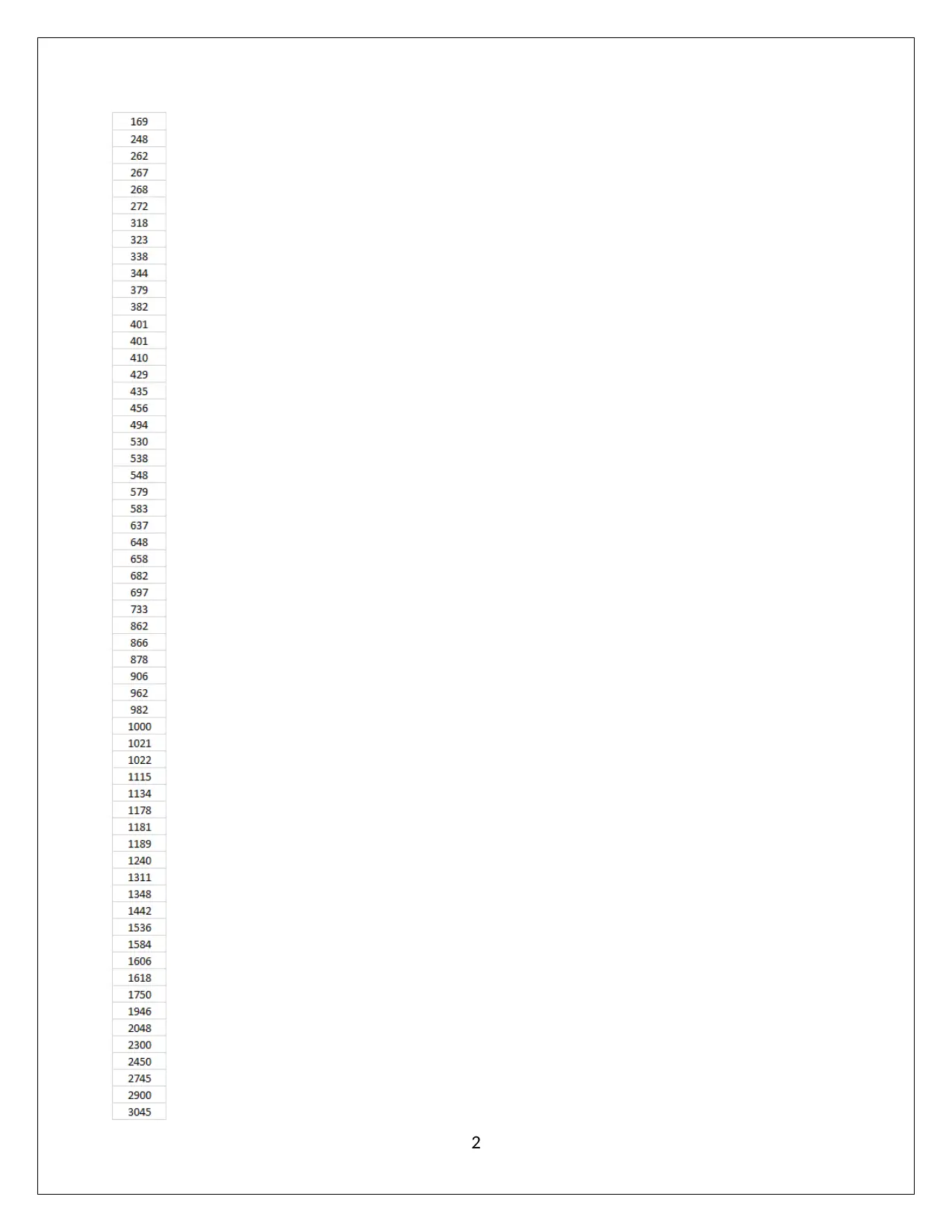
2
⊘ This is a preview!⊘
Do you want full access?
Subscribe today to unlock all pages.

Trusted by 1+ million students worldwide
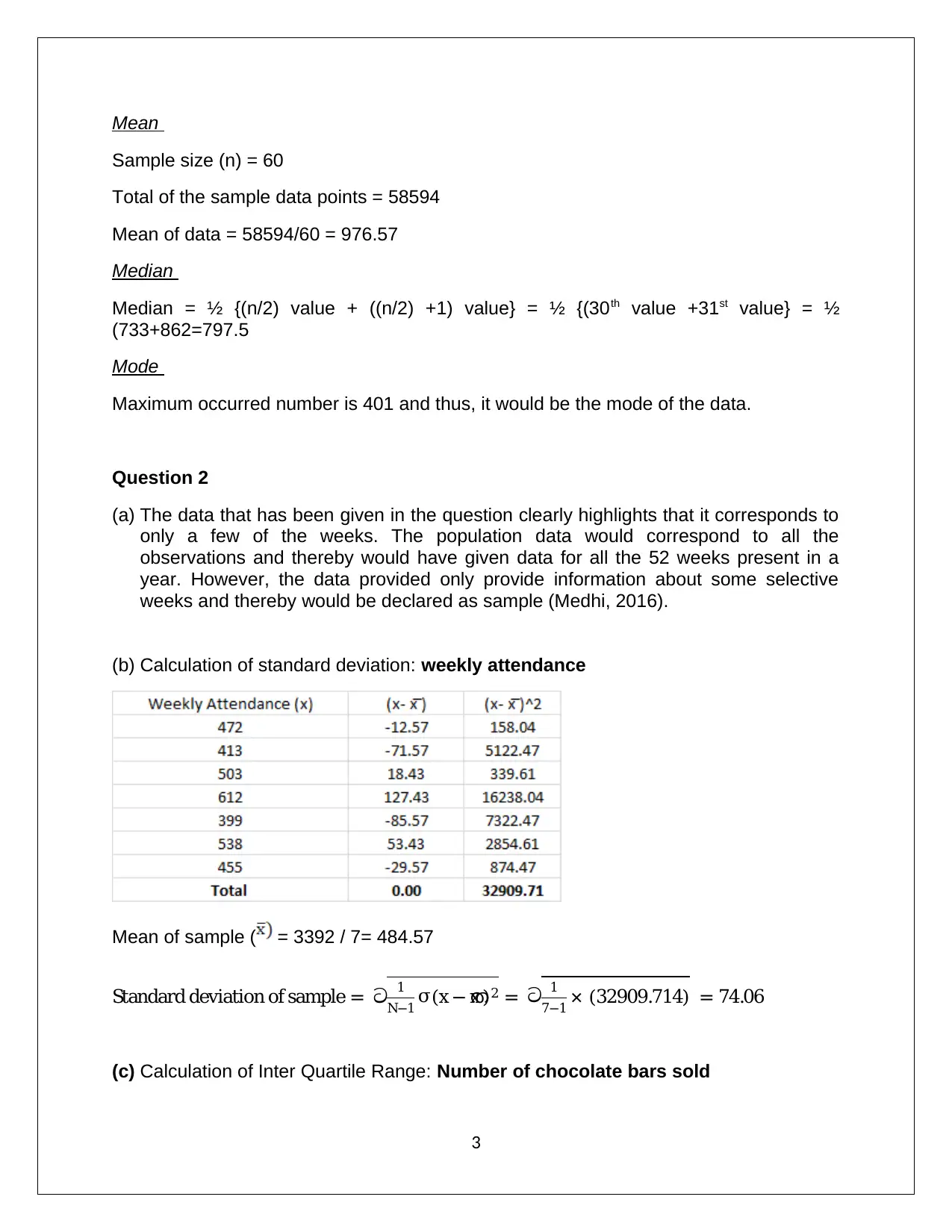
Mean
Sample size (n) = 60
Total of the sample data points = 58594
Mean of data = 58594/60 = 976.57
Median
Median = ½ {(n/2) value + ((n/2) +1) value} = ½ {(30th value +31st value} = ½
(733+862=797.5
Mode
Maximum occurred number is 401 and thus, it would be the mode of the data.
Question 2
(a) The data that has been given in the question clearly highlights that it corresponds to
only a few of the weeks. The population data would correspond to all the
observations and thereby would have given data for all the 52 weeks present in a
year. However, the data provided only provide information about some selective
weeks and thereby would be declared as sample (Medhi, 2016).
(b) Calculation of standard deviation: weekly attendance
Mean of sample ( = 3392 / 7= 484.57
Standard deviation of sample = ට 1
N−1 σ(x − xത) 2 = ට 1
7−1 × (32909.714) = 74.06
(c) Calculation of Inter Quartile Range: Number of chocolate bars sold
3
Sample size (n) = 60
Total of the sample data points = 58594
Mean of data = 58594/60 = 976.57
Median
Median = ½ {(n/2) value + ((n/2) +1) value} = ½ {(30th value +31st value} = ½
(733+862=797.5
Mode
Maximum occurred number is 401 and thus, it would be the mode of the data.
Question 2
(a) The data that has been given in the question clearly highlights that it corresponds to
only a few of the weeks. The population data would correspond to all the
observations and thereby would have given data for all the 52 weeks present in a
year. However, the data provided only provide information about some selective
weeks and thereby would be declared as sample (Medhi, 2016).
(b) Calculation of standard deviation: weekly attendance
Mean of sample ( = 3392 / 7= 484.57
Standard deviation of sample = ට 1
N−1 σ(x − xത) 2 = ට 1
7−1 × (32909.714) = 74.06
(c) Calculation of Inter Quartile Range: Number of chocolate bars sold
3
Paraphrase This Document
Need a fresh take? Get an instant paraphrase of this document with our AI Paraphraser
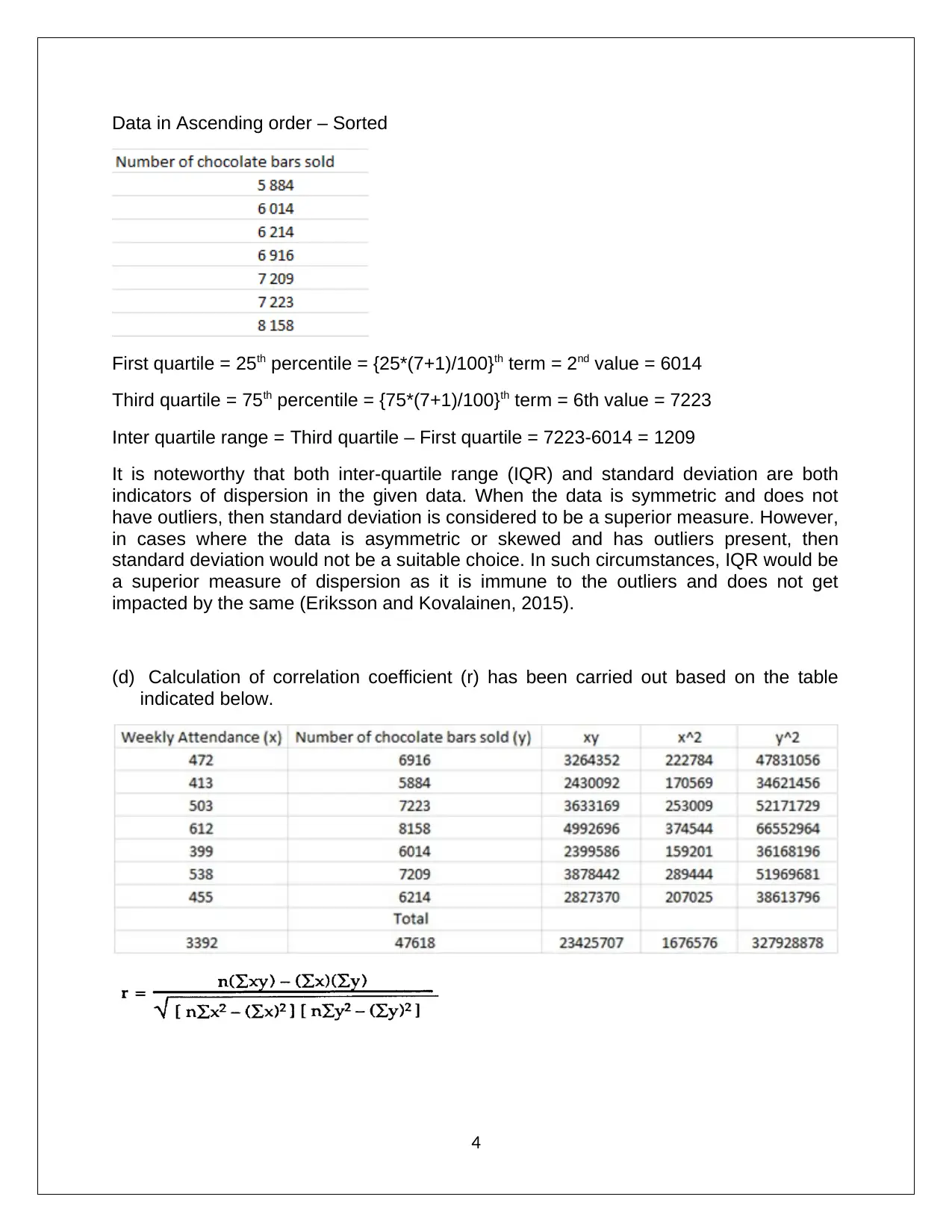
Data in Ascending order – Sorted
First quartile = 25th percentile = {25*(7+1)/100}th term = 2nd value = 6014
Third quartile = 75th percentile = {75*(7+1)/100}th term = 6th value = 7223
Inter quartile range = Third quartile – First quartile = 7223-6014 = 1209
It is noteworthy that both inter-quartile range (IQR) and standard deviation are both
indicators of dispersion in the given data. When the data is symmetric and does not
have outliers, then standard deviation is considered to be a superior measure. However,
in cases where the data is asymmetric or skewed and has outliers present, then
standard deviation would not be a suitable choice. In such circumstances, IQR would be
a superior measure of dispersion as it is immune to the outliers and does not get
impacted by the same (Eriksson and Kovalainen, 2015).
(d) Calculation of correlation coefficient (r) has been carried out based on the table
indicated below.
4
First quartile = 25th percentile = {25*(7+1)/100}th term = 2nd value = 6014
Third quartile = 75th percentile = {75*(7+1)/100}th term = 6th value = 7223
Inter quartile range = Third quartile – First quartile = 7223-6014 = 1209
It is noteworthy that both inter-quartile range (IQR) and standard deviation are both
indicators of dispersion in the given data. When the data is symmetric and does not
have outliers, then standard deviation is considered to be a superior measure. However,
in cases where the data is asymmetric or skewed and has outliers present, then
standard deviation would not be a suitable choice. In such circumstances, IQR would be
a superior measure of dispersion as it is immune to the outliers and does not get
impacted by the same (Eriksson and Kovalainen, 2015).
(d) Calculation of correlation coefficient (r) has been carried out based on the table
indicated below.
4
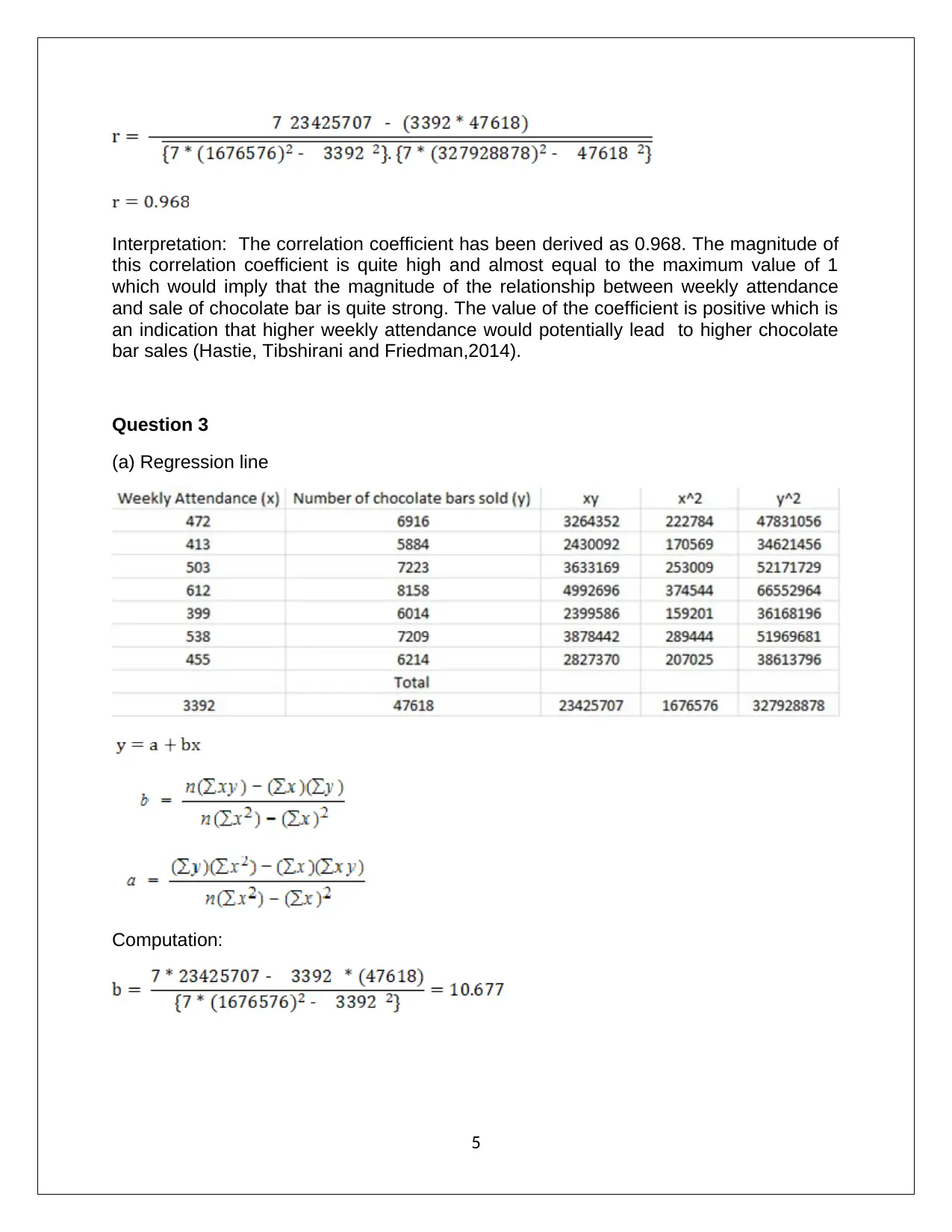
Interpretation: The correlation coefficient has been derived as 0.968. The magnitude of
this correlation coefficient is quite high and almost equal to the maximum value of 1
which would imply that the magnitude of the relationship between weekly attendance
and sale of chocolate bar is quite strong. The value of the coefficient is positive which is
an indication that higher weekly attendance would potentially lead to higher chocolate
bar sales (Hastie, Tibshirani and Friedman,2014).
Question 3
(a) Regression line
Computation:
5
this correlation coefficient is quite high and almost equal to the maximum value of 1
which would imply that the magnitude of the relationship between weekly attendance
and sale of chocolate bar is quite strong. The value of the coefficient is positive which is
an indication that higher weekly attendance would potentially lead to higher chocolate
bar sales (Hastie, Tibshirani and Friedman,2014).
Question 3
(a) Regression line
Computation:
5
⊘ This is a preview!⊘
Do you want full access?
Subscribe today to unlock all pages.

Trusted by 1+ million students worldwide
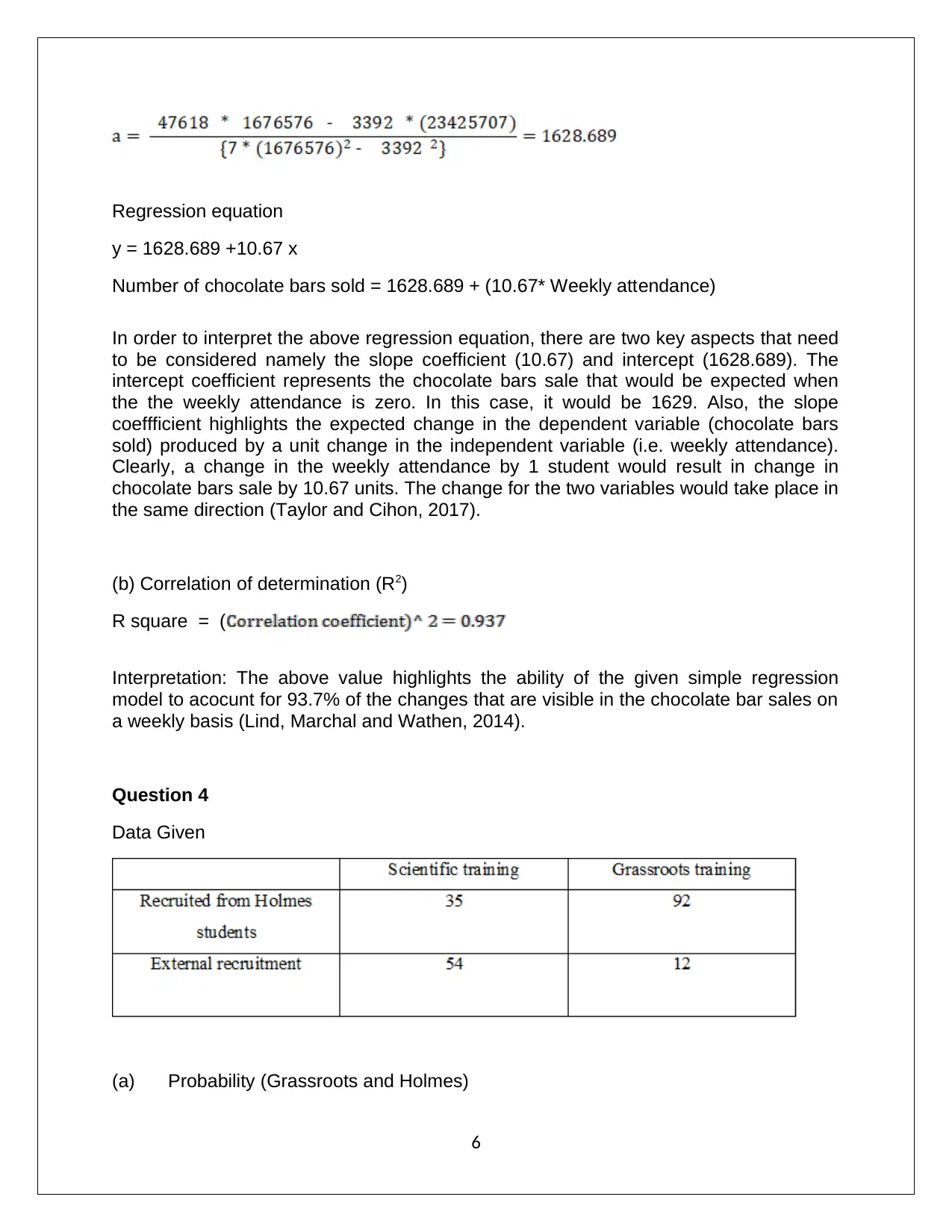
Regression equation
y = 1628.689 +10.67 x
Number of chocolate bars sold = 1628.689 + (10.67* Weekly attendance)
In order to interpret the above regression equation, there are two key aspects that need
to be considered namely the slope coefficient (10.67) and intercept (1628.689). The
intercept coefficient represents the chocolate bars sale that would be expected when
the the weekly attendance is zero. In this case, it would be 1629. Also, the slope
coeffficient highlights the expected change in the dependent variable (chocolate bars
sold) produced by a unit change in the independent variable (i.e. weekly attendance).
Clearly, a change in the weekly attendance by 1 student would result in change in
chocolate bars sale by 10.67 units. The change for the two variables would take place in
the same direction (Taylor and Cihon, 2017).
(b) Correlation of determination (R2)
R square = (
Interpretation: The above value highlights the ability of the given simple regression
model to acocunt for 93.7% of the changes that are visible in the chocolate bar sales on
a weekly basis (Lind, Marchal and Wathen, 2014).
Question 4
Data Given
(a) Probability (Grassroots and Holmes)
6
y = 1628.689 +10.67 x
Number of chocolate bars sold = 1628.689 + (10.67* Weekly attendance)
In order to interpret the above regression equation, there are two key aspects that need
to be considered namely the slope coefficient (10.67) and intercept (1628.689). The
intercept coefficient represents the chocolate bars sale that would be expected when
the the weekly attendance is zero. In this case, it would be 1629. Also, the slope
coeffficient highlights the expected change in the dependent variable (chocolate bars
sold) produced by a unit change in the independent variable (i.e. weekly attendance).
Clearly, a change in the weekly attendance by 1 student would result in change in
chocolate bars sale by 10.67 units. The change for the two variables would take place in
the same direction (Taylor and Cihon, 2017).
(b) Correlation of determination (R2)
R square = (
Interpretation: The above value highlights the ability of the given simple regression
model to acocunt for 93.7% of the changes that are visible in the chocolate bar sales on
a weekly basis (Lind, Marchal and Wathen, 2014).
Question 4
Data Given
(a) Probability (Grassroots and Holmes)
6
Paraphrase This Document
Need a fresh take? Get an instant paraphrase of this document with our AI Paraphraser
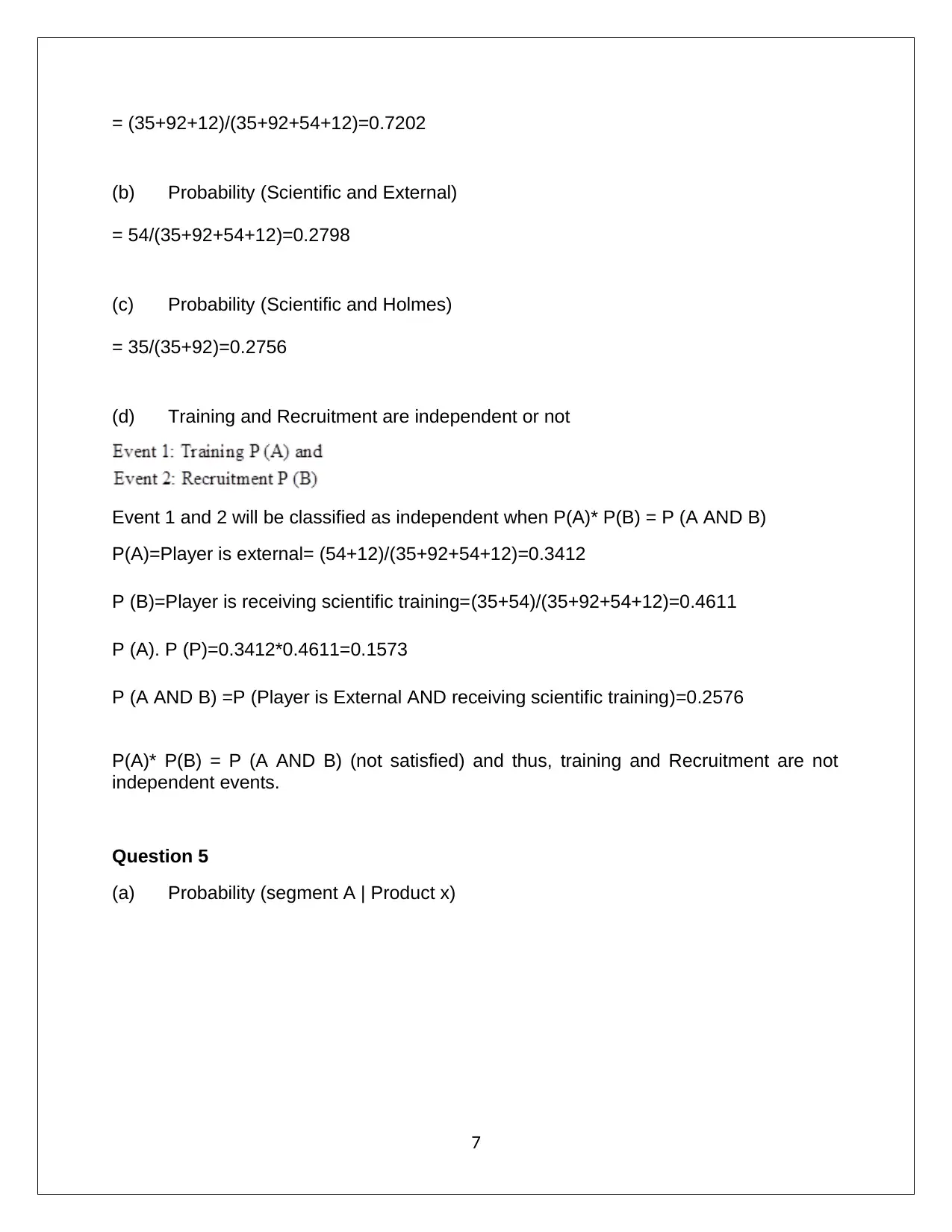
= (35+92+12)/(35+92+54+12)=0.7202
(b) Probability (Scientific and External)
= 54/(35+92+54+12)=0.2798
(c) Probability (Scientific and Holmes)
= 35/(35+92)=0.2756
(d) Training and Recruitment are independent or not
Event 1 and 2 will be classified as independent when P(A)* P(B) = P (A AND B)
P(A)=Player is external= (54+12)/(35+92+54+12)=0.3412
P (B)=Player is receiving scientific training=(35+54)/(35+92+54+12)=0.4611
P (A). P (P)=0.3412*0.4611=0.1573
P (A AND B) =P (Player is External AND receiving scientific training)=0.2576
P(A)* P(B) = P (A AND B) (not satisfied) and thus, training and Recruitment are not
independent events.
Question 5
(a) Probability (segment A | Product x)
7
(b) Probability (Scientific and External)
= 54/(35+92+54+12)=0.2798
(c) Probability (Scientific and Holmes)
= 35/(35+92)=0.2756
(d) Training and Recruitment are independent or not
Event 1 and 2 will be classified as independent when P(A)* P(B) = P (A AND B)
P(A)=Player is external= (54+12)/(35+92+54+12)=0.3412
P (B)=Player is receiving scientific training=(35+54)/(35+92+54+12)=0.4611
P (A). P (P)=0.3412*0.4611=0.1573
P (A AND B) =P (Player is External AND receiving scientific training)=0.2576
P(A)* P(B) = P (A AND B) (not satisfied) and thus, training and Recruitment are not
independent events.
Question 5
(a) Probability (segment A | Product x)
7
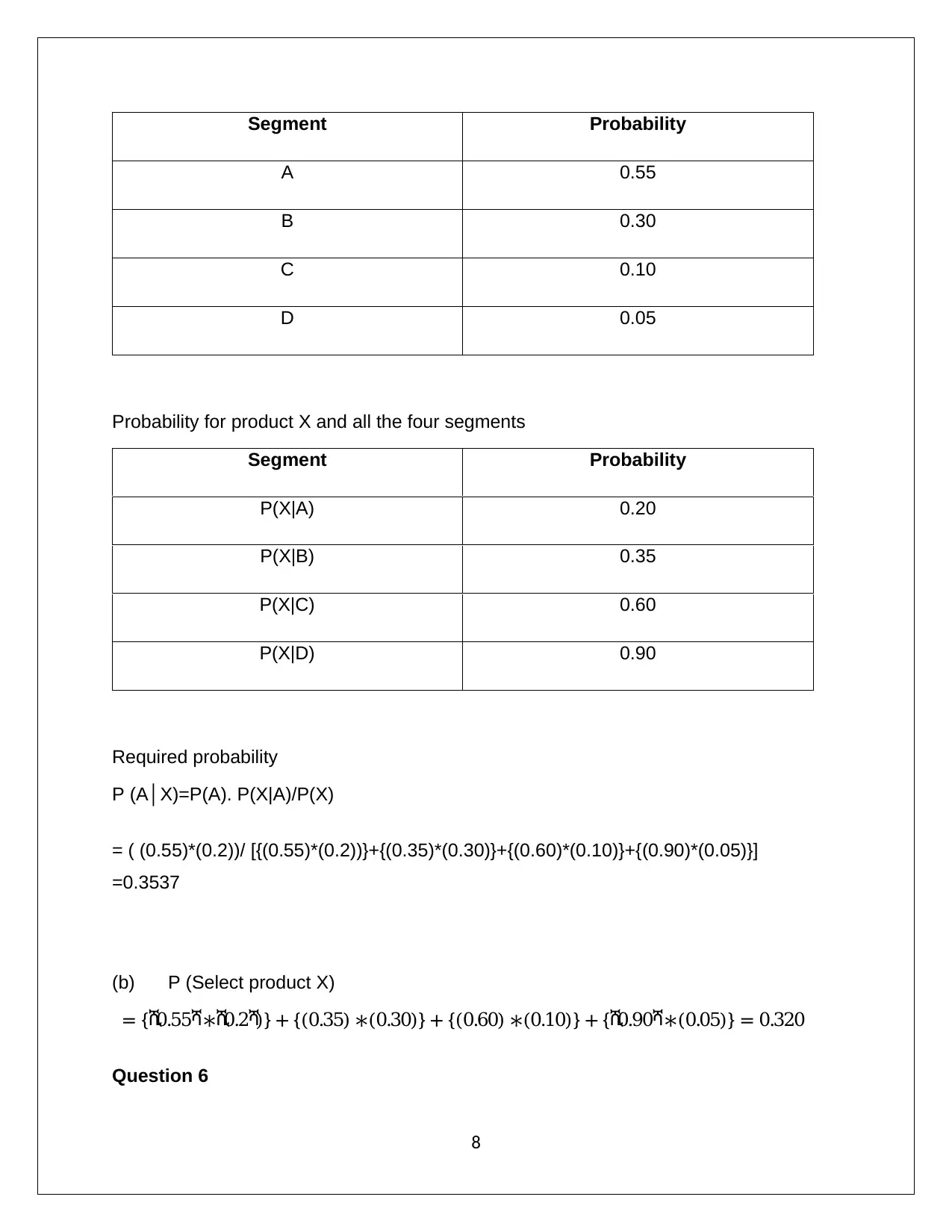
Segment Probability
A 0.55
B 0.30
C 0.10
D 0.05
Probability for product X and all the four segments
Segment Probability
P(X|A) 0.20
P(X|B) 0.35
P(X|C) 0.60
P(X|D) 0.90
Required probability
P (A│X)=P(A). P(X|A)/P(X)
= ( (0.55)*(0.2))/ [{(0.55)*(0.2))}+{(0.35)*(0.30)}+{(0.60)*(0.10)}+{(0.90)*(0.05)}]
=0.3537
(b) P (Select product X)
= {ሺ0.55ሻ∗ሺ0.2ሻ)} + {(0.35) ∗(0.30)} + {(0.60) ∗(0.10)} + {ሺ0.90ሻ∗(0.05)} = 0.320
Question 6
8
A 0.55
B 0.30
C 0.10
D 0.05
Probability for product X and all the four segments
Segment Probability
P(X|A) 0.20
P(X|B) 0.35
P(X|C) 0.60
P(X|D) 0.90
Required probability
P (A│X)=P(A). P(X|A)/P(X)
= ( (0.55)*(0.2))/ [{(0.55)*(0.2))}+{(0.35)*(0.30)}+{(0.60)*(0.10)}+{(0.90)*(0.05)}]
=0.3537
(b) P (Select product X)
= {ሺ0.55ሻ∗ሺ0.2ሻ)} + {(0.35) ∗(0.30)} + {(0.60) ∗(0.10)} + {ሺ0.90ሻ∗(0.05)} = 0.320
Question 6
8
⊘ This is a preview!⊘
Do you want full access?
Subscribe today to unlock all pages.

Trusted by 1+ million students worldwide

(a) Probability that 2 or lower than 2 customers will purchase
Binomial distribution
Given information
(b) Probability that in 2 minutes, 9 customers would enter in the shop.
Poisson distribution
9
Binomial distribution
Given information
(b) Probability that in 2 minutes, 9 customers would enter in the shop.
Poisson distribution
9
Paraphrase This Document
Need a fresh take? Get an instant paraphrase of this document with our AI Paraphraser
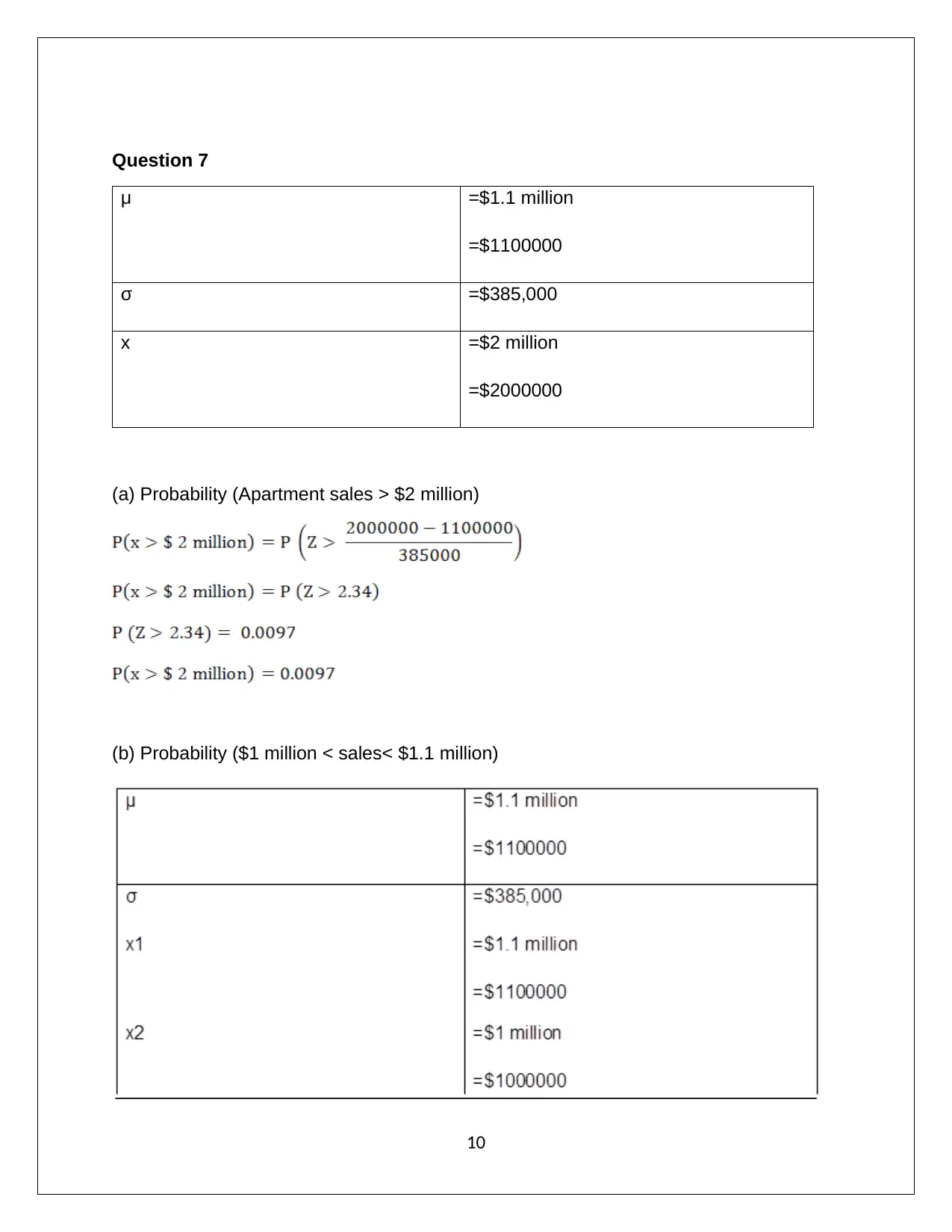
Question 7
μ =$1.1 million
=$1100000
σ =$385,000
x =$2 million
=$2000000
(a) Probability (Apartment sales > $2 million)
(b) Probability ($1 million < sales< $1.1 million)
10
μ =$1.1 million
=$1100000
σ =$385,000
x =$2 million
=$2000000
(a) Probability (Apartment sales > $2 million)
(b) Probability ($1 million < sales< $1.1 million)
10

P (1000000<x<1100000)=P ((1000000-1100000)/385000<(x-μ)/σ< (1100000-
1100000)/385000)=P( -0.26<z<0)
From z table P (z<-0.26)=0.3975
P (z<0)=0.5
P (1000000<x<1100000)=0.5-0.3975=0.1025
Question 8
(a) In order to determine if the underlying data can be considered as normally
distributed or not, consideration needs to be given the central limits theorem. This
theorem states that if the number of observations is adequately large i.e. (greater
than 30), then it would be fair to assume that the underlying sample takes a normal
distribution irrespective of the original distribution being normal (Taylor and Cihon,
2017).
(b) Assistant called 45 investors and out of which 11 investors show willingness to
invest in new fund.
Proportion of agreed investors = 11 /45 = 0.24
Standard error for proportion of sample =√(((1-p)p)/n)= √(0.24(1-0.24)/45)=0.064
Probability (p>30%)=P (z> (0.3-0.24)/0.064)=P(z>0.87)
P (z>0.87)=0.192
Probability (p>30%)=0.192
11
1100000)/385000)=P( -0.26<z<0)
From z table P (z<-0.26)=0.3975
P (z<0)=0.5
P (1000000<x<1100000)=0.5-0.3975=0.1025
Question 8
(a) In order to determine if the underlying data can be considered as normally
distributed or not, consideration needs to be given the central limits theorem. This
theorem states that if the number of observations is adequately large i.e. (greater
than 30), then it would be fair to assume that the underlying sample takes a normal
distribution irrespective of the original distribution being normal (Taylor and Cihon,
2017).
(b) Assistant called 45 investors and out of which 11 investors show willingness to
invest in new fund.
Proportion of agreed investors = 11 /45 = 0.24
Standard error for proportion of sample =√(((1-p)p)/n)= √(0.24(1-0.24)/45)=0.064
Probability (p>30%)=P (z> (0.3-0.24)/0.064)=P(z>0.87)
P (z>0.87)=0.192
Probability (p>30%)=0.192
11
⊘ This is a preview!⊘
Do you want full access?
Subscribe today to unlock all pages.

Trusted by 1+ million students worldwide
1 out of 13
Related Documents
Your All-in-One AI-Powered Toolkit for Academic Success.
+13062052269
info@desklib.com
Available 24*7 on WhatsApp / Email
![[object Object]](/_next/static/media/star-bottom.7253800d.svg)
Unlock your academic potential
Copyright © 2020–2025 A2Z Services. All Rights Reserved. Developed and managed by ZUCOL.





